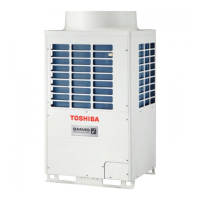What does L06 error mean on Toshiba MMY-MAP1004HT8-E Air Conditioner?
- PPamela WatsonSep 14, 2025
The error code L06 on your Toshiba Air Conditioner indicates that two or more prior indoor units exist.

What does L06 error mean on Toshiba MMY-MAP1004HT8-E Air Conditioner?
The error code L06 on your Toshiba Air Conditioner indicates that two or more prior indoor units exist.
What does error E08 mean on my Toshiba MMY-MAP1004HT8-E?
The error code E08 on your Toshiba Air Conditioner indicates duplicated indoor addresses.
What does F31 error mean on Toshiba MMY-MAP1004HT8-E?
The error code F31 on your Toshiba Air Conditioner indicates an issue with the outdoor unit EEPROM.
What does error H02 mean on Toshiba Air Conditioner?
The error code H02 on your Toshiba Air Conditioner indicates a compressor error (Locked). This could be related to compressor 1, 2, or 3.
What does E07 error mean on Toshiba MMY-MAP1004HT8-E?
The error code E07 on your Toshiba Air Conditioner indicates an Indoor/Outdoor communication circuit error.
What does error E15 mean on my Toshiba MMY-MAP1004HT8-E Air Conditioner?
The error code E15 on your Toshiba Air Conditioner indicates that no indoor unit was detected during automatic addressing.
What does E06 error mean on Toshiba Air Conditioner?
The error code E06 on your Toshiba Air Conditioner indicates that the number of indoor units which received normally should be decreased.
What does F13 error mean on Toshiba MMY-MAP1004HT8-E Air Conditioner?
The error code F13 on your Toshiba Air Conditioner indicates a TH (Heat sink) sensor error, potentially related to compressor 1, 2, or 3.
What does F08 error mean on Toshiba Air Conditioner?
The error code F08 on your Toshiba Air Conditioner indicates a TO sensor error.
What does F05 error mean on Toshiba MMY-MAP1004HT8-E Air Conditioner?
The error code F05 on your Toshiba Air Conditioner indicates a TD2 sensor error.
| Brand | Toshiba |
|---|---|
| Model | MMY-MAP1004HT8-E |
| Category | Air Conditioner |
| Language | English |
Defines the qualifications and knowledge required for installation personnel.
Essential safety rules and warnings for installation and operation.
Specifies necessary tools and precautions for handling R410A refrigerant.
Details on connecting refrigerant pipes to the outdoor unit's service ports.
Steps for performing an airtightness test on the refrigerant piping system.
Procedures for detecting and sealing refrigerant leaks.
How to use the vacuum pump to remove moisture and air from the system.
Method for calculating and adding the correct amount of refrigerant.
Details on voltage, MCA, and MOCP for power supply.
Details on wiring types, sizes, and lengths for communication.
Guidance on selecting appropriate wiring for power connections.
Procedure for automatically setting unit addresses.
Steps for manually setting unit addresses via remote controller or switches.
Detailed instructions for setting addresses using a wired remote controller.
Further steps for setting unit addresses with a wired remote controller.
Various methods to conduct a test run of the air conditioning system.
How to perform test runs using the interface board switches.
How to interpret 7-segment display codes for troubleshooting.
List of check codes and their corresponding error indications.
Information on refrigerant concentration limits and room volume requirements.












